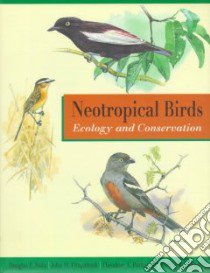Neotropical Birds - 9780226776309
Un libro in lingua di Stotz Douglas F. (EDT) Fitzpatrick John W. Parker Theodore A. Moskovits Debra K. edito da Univ of Chicago Pr, 1996
- € 63.80
- Il prezzo è variabile in funzione del cambio della valuta d’origine
Bird communities are sensitive indicators of habitat type and condition. Therefore careful ornithological surveys can provide quick, practical assessments of the ecological characteristics and conservation status of many terrestrial communities in the tropical Americas. This volume provides the data essential to the success of such surveys. It compiles, for the first time, information on the ecological and geographical distributions of all 4,037 bird species of the Neotropics, from Mexico south to Tierra del Fuego, including many migrant species.
Using this extensive database, the authors analyze priorities for conservation in the Neotropics, showing how bird communities can help determine which Neotropical regions and habitats are in most urgent need of protection. In almost three hundred pages of tables (also available on disk), the authors provide detailed information on each species' geographic range, habitat use, elevational limits, foraging levels, relative abundance, and sensitivity to human disturbance. With the data in this book, for example, one can pinpoint all bird species living in any Neotropical country at a specific elevation in a particular vegetation type. Much of this previously unpublished information was amassed by Theodore A. Parker III before his untimely death.
Careful analysis of this information suggests surprising and controversial conclusions. For instance, bird communities indicate that the current focus for conservation action in the Amazonian lowlands is misplaced: these forests are still relatively intact. Instead, biological communities that are narrowly restricted to the lower slopes of the Andes, to the tropical deciduous forests, and to the once-extensive grasslands and scrubs of central Brazil - communities still largely ignored by conservationists - are the ones facing most immediate risks from current development pressures.
This unparalleled wealth of finely detailed ecological information on Neotropical bird communities will prove invaluable to all Neotropical wildlife managers, conservation biologists, and serious birders.
Informazioni bibliografiche
- Titolo del Libro in lingua: Neotropical Birds
- Sottotitolo: Ecology and Conservation
- Lingua: English
- Autori : Stotz Douglas F. (EDT) Fitzpatrick John W. Parker Theodore A. Moskovits Debra K.
- Editore: Univ of Chicago Pr
- Collana: Univ of Chicago Pr (Paperback)
- Data di Pubblicazione: 01 Marzo '96
- Genere: NATURE
- Argomenti : Birds Latin America Birds Habitat Latin America Birds Ecology Latin America
- Dimensioni mm: 285 x 222 x 31
- ISBN-10: 0226776301
- EAN-13: 9780226776309


